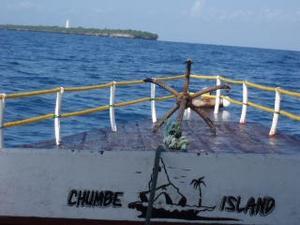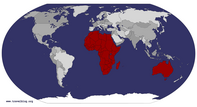Advertisement
Published: November 14th 2006

 All aboard!
All aboard!
Riding the Chumbe ExpressThis blog is especially dedicated to our good friends Michael, Sue, Harry and Ruby. Thank you so much for your generous gift. We loved and appreciated our time on Chumbe and still to this day it remains one of the highlights of our trip. From our hotel in Stone Town we hiked the 7km to the Mbweni Ruins Hotel. By the time we arrived we were ready to accept a ride from one of the hundred or so taxis that stopped and told us that it was too far to walk on this hot day and that they would be happy to take us the rest of the way, naturally for a special price. "The Chumbe Express" was ready and waiting which meant that there was no time to get comfortable and have a refreshing drink in the shade by the beach side pool. Had there have been time we would never have made it to Chumbe. Chumbe Island Coral Park is a 100% eco friendly resort (5 star compared to our tent and previous accomodations) that includes the first marine park in Tanzania boasting over 200 species of coral and 400 species of fish, lobster, turtles and dolphins. It also

 Chumbe Island
Chumbe Island
From the lighthousehosts a dense forest, home to fossilised corals, mangroves and huge shady boabab trees, endangered birds and animal species and giant coconut crabs, the largest land living crabs in the world. Everything on Chumbe is designed to fully protect the fragile nature of this unique island reserve. Each of the palm thatched bungalows are nestled in the forest and have unspoilt beach views. They are constructed entirely of local material and are designed according to state of the art eco architecture. They are all equipped to catch, filter and solar heat their own water, provide hand held solar torches and sport beds three times the size of our tent with lovely bed linen, soft fluffy towels, local spice scented soaps, his and hers sarongs and private (and again) eco friendly bathrooms. The best aspect of the bungalows however is the fact that there are only 7 of them, meaning that at any one time there are a maximum of only 14 guests. From the moment we arrived on Chumbe the staff went out of their way to pamper us and ensure that we were comfortable. Manager Godfrey gave us a guided tour of the facilities including the reading lounge, dining

 Reading Lounge
Reading Lounge
This must be just like living in paradise...area and resource center that was a wealth of information about the park and the local area. One of the many fabulous innovations of the park was in providing free, updated and accesible information in the form of books, posters and hands on activities to Tanzanian schools with the aim of educating teachers and students alike about aquatic life and the need to preserve it. After we'd been shown to our bungalow Mpishi (chef) John introduced himself and told us of the exotic dishes he was preparing for our lunch. We were then introduced to Jaku who was to be our personal guide for all the snorkelling trips, nature walks and lighthouse sundowners that we were going to do and that were all included in the price, which thanks again to our above mentioned friends, we didn't have to worry about. Another of the parks initiatives was in providing training and employment to local fisher and townspeople to enable them to guide tourists and teach the students about the park and nature. Once we were settled in and organised we went on the first of our two snorkelling trips. Submerging ourselves in the cool, clear, tropical water was like entering

 Lovin Paradise
Lovin Paradise
...and I dont wanna go home.another world. The colours and variety of corals and marine life were unbelievable and in every direction that we looked we saw something more fascinating than that of just a few moments ago. Not only did Jaku know where to find certain things of interest he had the knowledge to explain about its lifestyle and habitat, reproduction and defense mechanisms, life expectancy etc. He was proving himself to be a floating encyclopaedia. In addition to the endless corals, urchins and numerous other marine flora and fauna (sorry Jaku but I cant remember all the scientific names) we saw poisonous lion fish, devil starfish, very well camoflaged and prehistoric looking crocodile fish, sea turtles and lobsters that were so large they needed body guards. One of the problems that the marine park occasionally has is with poachers. Under the cover of night and armed with scuba gear and hi tech spear guns, the poachers try to invade the reserve as the unprotected waters surrounding Chumbe have been fished and blasted to oblivion. The only reason that we re emerged from the super natural underwater world was because Mpishi John had our taste buds salivating from the moment we were introduced. Our
buffet lunch consisted of exotic spiced curries, fresh juicy crayfish and a mixed seafood platter, garden and potato salads then to top it off tropical fruits, apple crumble, spiced coffees and herbal teas. It took us quite sometime to remove ourselves from the beautiful and secluded beachfront setting in which we ate the tastiest and most creative food we'd come across in all of Africa and still then all we could manage was an afternoon read/siesta alternating between hammocks and bean bag style cushions that were scattered in quiet shady spots all over the island. "How's the serenity?" When we were rested and the temperature had decreased sufficiently Jaku took us on a short nature walk. The encyclopaedia in him came out again and he was able to point out and explain to us about Coconut and Hermit crabs. Coconut crabs are named so because they climb to the top of the palm trees, saw off the coconuts with their saw like front claws, climb back down to retrieve the coconuts and then saw them open to eat. There are so many Hermit crabs that we had to watch where we stepped. We also saw fossilised corals and the very

 Coconut Crab
Coconut Crab
And this one was a baby!shy and endangered Ader Duiker. To end a perfect day we climbed the 104 year old gas lantern lighthouse to watch a spectacular sunset over mainland Tanzania. One of Chumbes proudest selling points is that there is no television, mobile reception or even loud music. 99 times out of 100 this would suit us just fine, but the Kombe la Dunia had reached the qtr final stage and even though we were still sore after Australias controversial exit, all the big teams were facing off. The staff of Chumbe had been permitted a small television (run from a solar powered generator) in their quarters to watch the night time matches. It was another example of football bringing us together with the locals and we spent a few hours huddled around the box cheering and clapping with the staff. The only person who was not happy about this arrangement was Mpishi John. Not only was he too busy furiously cooking away, he then had to go searching for his diners. Once he got us into the dining area (with the aid of a big wooden spoon) we quickly remembered our priorities as he had put on another delicious buffet culminating in

 Dani and Jaku
Dani and Jaku
Thanks for a great two days mate.a creme caramel to die for. I would feel terrible if at this time I didn't mention how superb and personal the service was from our waitstaff. Making our day even more perfect was the fact that both England and Brazil had been knocked out of the Kombe la Dunia, meaning that 90% of Africans would have to find a new team to support! With the addition of a hearty and healthy breakfast and new and amazing delicasies to devour for lunch and dinner, our second day on Chumbe was an almost carbon copy of the first. Once again amazing snorkelling and nature walks with Jaku in which we saw and learnt yet more things, several more hours of r & r, a perfect sunset and Kombe la Dunia with the staff. Twice during the day the staffs attention to detail greatly impressed us. In passing we had mentioned to Jaku that we were interested in butterflies. Whilst we were lazing he came across some particularly colourful butterflies feeding on a flowering tree. He took us to see them and upon closer inspection he realised that he had not seen this type before which was very exciting for him. Also,

 Rare sightings
Rare sightings
endangered or undiscovered?the way in which our bungalow had been cleaned and then later turned down gave it a very homely and welcoming feel. After two days and nights soaking up the beauty, tranquility, luxury and especially friendliness of Chumbe we now had kubwa matata moja (one big problem). It was time to leave. We gave and received heartfelt farewells and thankyous to all the staff and hopped back on "The Chumbe Express" for the journey first back to The Mbweni Ruins Hotel and then back to the madness of Stone Town, which we knew for sure, we this time weren't going to walk! Our two days of luxury on Chumbe was precisely what we needed in order to recharge our batteries and recover from a recent bout of malaria, but also to experience some true and amazing African food and hospitality. Thankyou Chumbe.
Advertisement
Tot: 0.069s; Tpl: 0.016s; cc: 17; qc: 23; dbt: 0.0387s; 1; m:domysql w:travelblog (10.17.0.13); sld: 1;
; mem: 1.1mb










Mandy and Tony
non-member comment
You have to become an author when you finally reach home again. Having a wonderful time just reading about it all. Hope you are both fully recovered from the malaria. Take care and lots of love. Also thank you for the postcard. Mandy xxxxxx